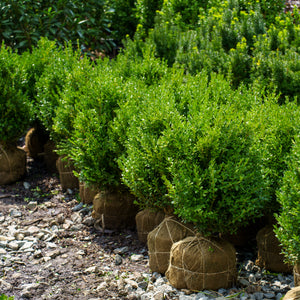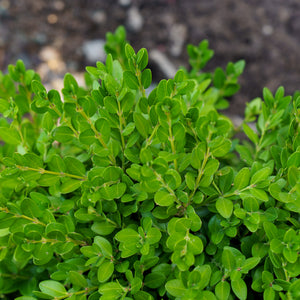The Boxwood Guide
Boxwood (Buxus) is a classic evergreen shrub that plays a foundational role in landscape design. Valued for its dense, small-leaved foliage and natural ability to be pruned into hedges, borders, spheres, or topiary shapes, boxwood is synonymous with structure, formality, and year-round greenery. Its versatility and durability have made it a favorite for traditional gardens, modern designs, and everything in between.
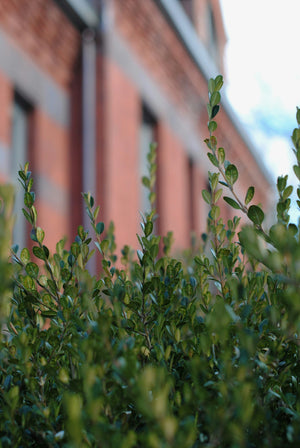
About
Boxwoods belong to the Buxaceae family and include numerous species and hybrids native to Europe, Asia, and the Americas. The most commonly cultivated species include Buxus sempervirens (common boxwood), Buxus microphylla (littleleaf boxwood), and Buxus sinica var. insularis (Korean boxwood). These evergreen shrubs are known for their fine texture, slow to moderate growth rate, and exceptional adaptability.
Cultivars such as Buxus x 'Green Velvet', and Buxus microphylla 'Winter Gem' are widely used in residential and commercial landscapes. Buxus microphylla 'Golden Triumph' adds a splash of variegated gold and green color, while upright growers like Buxus sempervirens 'Graham Blandy' provide vertical structure to formal gardens. Cold-hardy cultivars like Buxus microphylla var. insularis 'Tide Hill' and Buxus sempervirens 'Vardar Valley' are well-suited for northern zones.
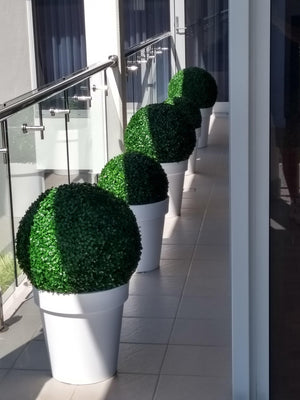
PLANTING
Boxwood planting success depends on choosing the right conditions and proper spacing:
- USDA Hardiness Zones: Most boxwoods thrive in Zones 5–9, with some cold-hardy varieties extending into Zone 4.
- Soil: Prefers well-drained, loamy soil with a pH between 6.5 and 7.2. Boxwoods do not tolerate waterlogged or extremely dry soils.
- Sunlight: Performs best in partial shade to full sun. Protection from winter wind and full southern exposure in colder zones is recommended to prevent bronzing.
- Watering: Keep soil consistently moist after planting. Once established, boxwood is moderately drought-tolerant but benefits from regular watering during dry spells.
- Spacing: Space boxwood shrubs 2 to 5 feet apart depending on cultivar size and desired density. Proper spacing ensures good airflow and reduces the risk of disease.
- Planting Time: Best planted in early spring or fall when temperatures are moderate. Container-grown boxwood can be planted throughout the growing season with care.

CARE
Boxwood is known for its tidy appearance, and regular maintenance helps preserve its form and health. However, it’s also important to watch for boxwood blight—a serious fungal disease that can cause leaf spots, defoliation, and dieback. Choosing blight-resistant cultivars and maintaining good airflow can help prevent outbreaks.
- Watering: Water deeply and consistently during the first season. Mature plants require less frequent watering but benefit from deep watering during hot, dry periods.
- Fertilizing: Apply a balanced, slow-release fertilizer in early spring. Avoid overfeeding, which may encourage weak growth.
- Pruning: Light pruning in late spring after the first flush of growth helps maintain shape. More substantial shaping should be done in late winter or early spring before new growth begins.
- Mulching: Apply a 2–3 inch layer of mulch around the base, keeping it clear of the trunk, to retain soil moisture and regulate temperature.
- Winter Care: Protect from winter burn by wrapping with burlap or applying anti-desiccant sprays in exposed locations.
- Disease Management: To reduce the risk of boxwood blight, avoid overhead watering, disinfect pruning tools between cuts, and remove and destroy any infected plant material.
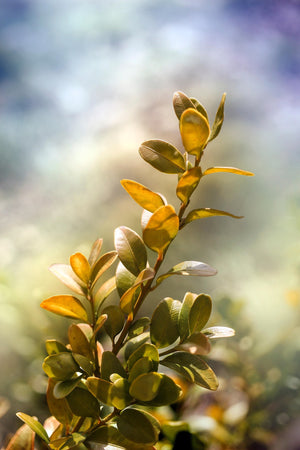
HOW TO USE
Boxwood’s structural qualities and evergreen foliage make it ideal for creating focal points and providing year-round definition:
- Formal Hedges: Perfect for framing walkways, borders, or patios with symmetrical, clipped rows.
- Foundation Plantings: Adds all-season greenery and softens the base of buildings or walls.
- Topiary and Containers: Use varieties like Buxus sempervirens 'Suffruticosa' for sculpted designs or pots on porches and terraces.
- Mixed Beds: Combine with perennials like lavender, hellebore, or hydrangea for contrasting textures and seasonal color.
- Parterre Gardens: Ideal for creating the classic look of knot gardens and boxwood-edged planting beds.
Boxwood also pairs well with ornamental grasses, evergreen groundcovers, and flowering shrubs like azaleas or roses for balance and interest.
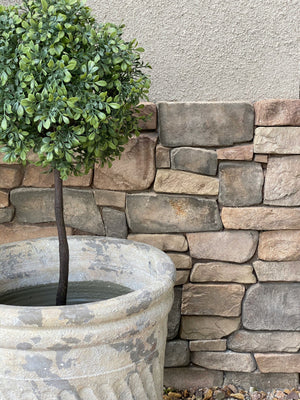
Common Questions
- Do deer eat boxwood? Boxwoods are generally deer-resistant due to their bitter-tasting foliage.
- Do rabbits eat boxwood? Rabbits typically avoid boxwood, though young plants may occasionally be nibbled.
- Are boxwood toxic to dogs? Yes, all parts of the plant are mildly toxic and may cause vomiting or diarrhea if ingested.
- Are boxwood toxic to cats? Yes, boxwood is toxic to cats and should be planted out of their reach.
- When to trim boxwood? Trim boxwood in late spring to early summer. Avoid pruning in fall to prevent new growth before winter.
- Do boxwoods change color? In winter, some varieties may bronze or yellow slightly, especially in wind-exposed or sunny areas. This is usually temporary.
- How to prune boxwood? Use sharp, clean shears to remove dead tips and shape plants. Avoid cutting into old wood unless rejuvenating.
- How fast do boxwood grow? Boxwoods grow slowly to moderately, adding 3–6 inches per year depending on the variety.
- What to plant in front of boxwoods? Consider seasonal color from bulbs, perennials like salvia or sedum, or low-growing groundcovers for contrast.
- How to plant boxwood? Dig a hole twice as wide as the root ball but no deeper. Backfill with native soil and water thoroughly.
- Are boxwoods evergreen? Yes, boxwoods are evergreen, providing foliage year-round.
- How far apart to plant boxwoods? Plant 2–5 feet apart depending on the mature size of the cultivar and the intended design (hedge vs. specimen).
Conclusion
Boxwoods are foundational plants that bring structure, evergreen presence, and design versatility to the landscape. Whether clipped into precise shapes, allowed to grow naturally, or used to frame a formal walkway, their reliability and elegance have stood the test of time. For gardeners seeking a dependable focal point with year-round appeal, boxwood remains an unrivaled choice.
The Boxwood Collection
Sold Out
Sold Out


